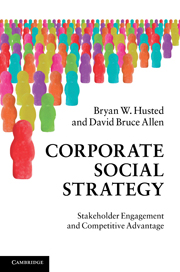Book contents
- Frontmatter
- Contents
- Figures
- Tables
- Acknowledgments
- 1 Introduction
- Part I Fundamentals
- Part II The process of developing corporate social strategy
- Part III Implementing social strategy
- 10 Organizing for social strategy
- 11 Corporate social strategy management and the multinational firm
- 12 Measurement and evaluation
- 13 The future of social strategy
- Bibliography
- Index
11 - Corporate social strategy management and the multinational firm
Published online by Cambridge University Press: 05 June 2012
- Frontmatter
- Contents
- Figures
- Tables
- Acknowledgments
- 1 Introduction
- Part I Fundamentals
- Part II The process of developing corporate social strategy
- Part III Implementing social strategy
- 10 Organizing for social strategy
- 11 Corporate social strategy management and the multinational firm
- 12 Measurement and evaluation
- 13 The future of social strategy
- Bibliography
- Index
Summary
Introduction
Though there is a strong body of theory and research on how multinationals organize their market and product strategies across borders, relatively little is known about their global organizational strategies for social issues management (Gnyawali, 1996; Meyer, 2004). We do know, however, that global MNEs often do not respond effectively to issues of importance in their host countries (Logsdon and Wood, 2005). Highly publicized examples of failed cross-border social issues management by multinationals include global protests and consumer boycotts of Nestlé following the baby formula scandal in Africa and of Nike in response to revelations of child labor abuses by its outsourcing partners in Asia.
It is common practice for global MNEs to centralize social issues management and leave local market units with limited functions and small staffs that are then unable to monitor and respond effectively. This problem is not limited to highly publicized crises that go international. In fact, most social issues management failures come from entering new markets with products and advertising that have enjoyed success at home, but when transplanted, may not be properly adapted to local culture and values.
- Type
- Chapter
- Information
- Corporate Social StrategyStakeholder Engagement and Competitive Advantage, pp. 238 - 260Publisher: Cambridge University PressPrint publication year: 2010



